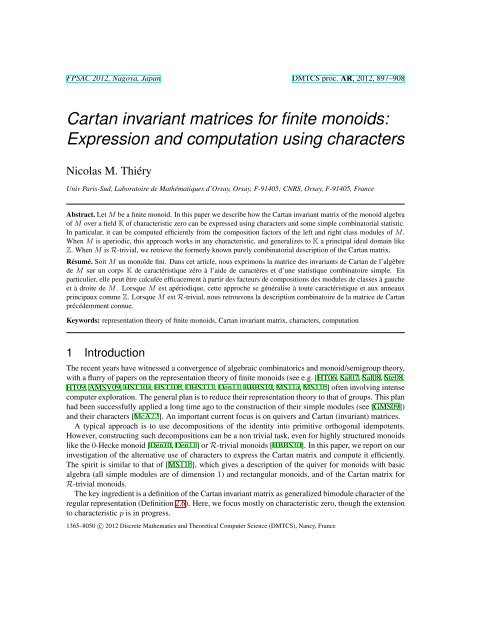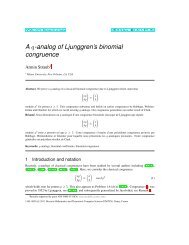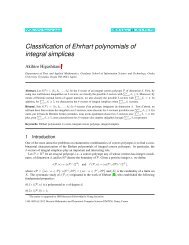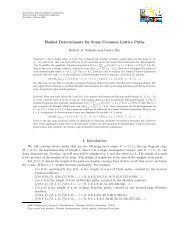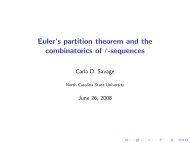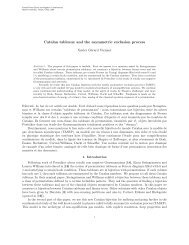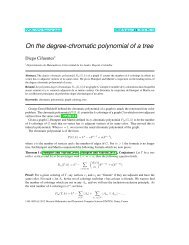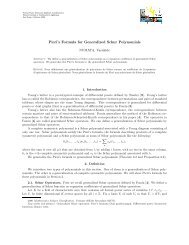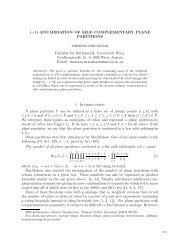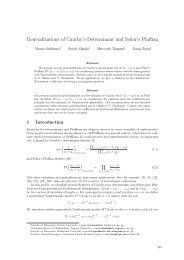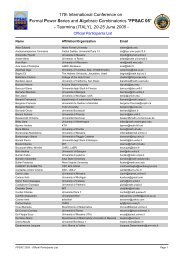Cartan invariant matrices for finite monoids - Nagoya University
Cartan invariant matrices for finite monoids - Nagoya University
Cartan invariant matrices for finite monoids - Nagoya University
Create successful ePaper yourself
Turn your PDF publications into a flip-book with our unique Google optimized e-Paper software.
FPSAC 2012, <strong>Nagoya</strong>, Japan DMTCS proc. AR, 2012, 897–908<br />
<strong>Cartan</strong> <strong>invariant</strong> <strong>matrices</strong> <strong>for</strong> <strong>finite</strong> <strong>monoids</strong>:<br />
Expression and computation using characters<br />
Nicolas M. Thiéry<br />
Univ Paris-Sud, Laboratoire de Mathématiques d’Orsay, Orsay, F-91405; CNRS, Orsay, F-91405, France<br />
Abstract. Let M be a <strong>finite</strong> monoid. In this paper we describe how the <strong>Cartan</strong> <strong>invariant</strong> matrix of the monoid algebra<br />
of M over a field K of characteristic zero can be expressed using characters and some simple combinatorial statistic.<br />
In particular, it can be computed efficiently from the composition factors of the left and right class modules of M.<br />
When M is aperiodic, this approach works in any characteristic, and generalizes to K a principal ideal domain like<br />
Z. When M is R-trivial, we retrieve the <strong>for</strong>merly known purely combinatorial description of the <strong>Cartan</strong> matrix.<br />
Résumé. Soit M un monoïde fini. Dans cet article, nous exprimons la matrice des <strong>invariant</strong>s de <strong>Cartan</strong> de l’algèbre<br />
de M sur un corps K de caractéristique zéro à l’aide de caractères et d’une statistique combinatoire simple. En<br />
particulier, elle peut être calculée efficacement à partir des facteurs de compositions des modules de classes à gauche<br />
et à droite de M. Lorsque M est apériodique, cette approche se généralise à toute caractéristique et aux anneaux<br />
principaux comme Z. Lorsque M est R-trivial, nous retrouvons la description combinatoire de la matrice de <strong>Cartan</strong><br />
précédemment connue.<br />
Keywords: representation theory of <strong>finite</strong> <strong>monoids</strong>, <strong>Cartan</strong> <strong>invariant</strong> matrix, characters, computation<br />
1 Introduction<br />
The recent years have witnessed a convergence of algebraic combinatorics and monoid/semigroup theory,<br />
with a flurry of papers on the representation theory of <strong>finite</strong> <strong>monoids</strong> (see e.g. [HT06, Sal07, Sal08, Ste08,<br />
HT09, AMSV09, HST10a, HST10b, DHST11, Den11, BBBS10, MS11a, MS11b] often involving intense<br />
computer exploration. The general plan is to reduce their representation theory to that of groups. This plan<br />
had been successfully applied a long time ago to the construction of their simple modules (see [GMS09])<br />
and their characters [McA72]. An important current focus is on quivers and <strong>Cartan</strong> (<strong>invariant</strong>) <strong>matrices</strong>.<br />
A typical approach is to use decompositions of the identity into primitive orthogonal idempotents.<br />
However, constructing such decompositions can be a non trivial task, even <strong>for</strong> highly structured <strong>monoids</strong><br />
like the 0-Hecke monoid [Den10, Den11] or R-trivial <strong>monoids</strong> [BBBS10]. In this paper, we report on our<br />
investigation of the alternative use of characters to express the <strong>Cartan</strong> matrix and compute it efficiently.<br />
The spirit is similar to that of [MS11b], which gives a description of the quiver <strong>for</strong> <strong>monoids</strong> with basic<br />
algebra (all simple modules are of dimension 1) and rectangular <strong>monoids</strong>, and of the <strong>Cartan</strong> matrix <strong>for</strong><br />
R-trivial <strong>monoids</strong>.<br />
The key ingredient is a definition of the <strong>Cartan</strong> <strong>invariant</strong> matrix as generalized bimodule character of the<br />
regular representation (Definition 2.6). Here, we focus mostly on characteristic zero, though the extension<br />
to characteristic p is in progress.<br />
1365–8050 c○ 2012 Discrete Mathematics and Theoretical Computer Science (DMTCS), Nancy, France
898 Nicolas M. Thiéry<br />
In Section 3 we setup the stage <strong>for</strong> character tables and their use to compute generalized characters of<br />
modules and bimodules, and in particular <strong>Cartan</strong> <strong>matrices</strong>. In Section 4 we re<strong>for</strong>mulate in this setting<br />
the construction of [McA72] of the character table, showing further that it is block triangular, with the<br />
diagonal blocks being the character tables of the subgroups (Theorem 4.1). We then derive a simple<br />
expression <strong>for</strong> the <strong>Cartan</strong> matrix, in term of the character table and of a simple combinatorial statistic on<br />
the monoid (Theorem 4.4). In the case of groups, this statistic boils down to the size of the centralizers.<br />
Then, we remark that the computations can be broken down into much smaller chunks using J -classes<br />
and the Schützenberger representation.<br />
In Section 5 we explore special cases. For J -trivial <strong>monoids</strong>, we retrieve our previous results [DHST11],<br />
without the need <strong>for</strong> orthogonal idempotents. For aperiodic <strong>monoids</strong>, the <strong>Cartan</strong> matrix takes a particularly<br />
simple <strong>for</strong>m (Theorem 5.2) which involves only left and right class modules, and works in any<br />
characteristic, or even over a principal ideal domain like Z.<br />
The point of this paper is that, once put together, most of the results are essentially straight<strong>for</strong>ward.<br />
Furthermore, they translate naturally into algorithms, an implementation of which is publicly available<br />
in Sage-Combinat. A detailed analysis remains to be carried out; however, roughly speaking, the<br />
algorithmic complexity <strong>for</strong> calculating the <strong>Cartan</strong> matrix drops from |M| 6 <strong>for</strong> usual algorithms <strong>for</strong> <strong>finite</strong><br />
dimensional algebras down to |M| 3 . In practice we could calculate in one hour the representation theory of<br />
the biHecke monoid of type A 4 , a monoid of cardinality 31103 with 120 simple representations, whereas<br />
this calculation was out of reach previously.<br />
Detailed proofs and examples will be given in an upcoming long version.<br />
Acknowledgments<br />
We would like to thank Florent Hivert, Stuart Margolis, Franco Saliola, and Anne Schilling <strong>for</strong> the continuing<br />
enlightening discussions that made this paper possible. This research was driven by computer<br />
exploration, using the open-source mathematical software Sage [S + 09] and its algebraic combinatorics<br />
features developed by the Sage-Combinat community [SCc08], together with the Semigroupe package<br />
by Jean-Éric Pin [Pin10b].<br />
2 Preliminaries<br />
2.1 Monoids: basic combinatorics and representation theory<br />
2.1.1 Monoids<br />
A monoid is a set M together with a binary operation · : M × M → M such that we have closure<br />
(x · y ∈ M <strong>for</strong> all x, y ∈ M), associativity ( (x · y) · z = x · (y · z) <strong>for</strong> all x, y, z ∈ M), and the existence<br />
of an identity element 1 ∈ M (which satistfies 1 · x = x · 1 = x <strong>for</strong> all x ∈ M). In this paper, unless<br />
explicitly mentioned, all <strong>monoids</strong> are <strong>finite</strong>. We use the convention that A ⊆ B denotes A a subset of B,<br />
and A ⊂ B denotes A a proper subset of B.<br />
Monoids come with a far richer diversity of features than groups, but collections of <strong>monoids</strong> can often<br />
be described as varieties satisfying a collection of algebraic identities and closed under subquotients and<br />
<strong>finite</strong> products (see e.g. [Pin86, Pin10a] or [Pin10a, Chapter VII]). Groups are an example of a variety of<br />
<strong>monoids</strong>, as are all of the classes of <strong>monoids</strong> described in this paper. In this section, we recall the basic<br />
tools <strong>for</strong> <strong>monoids</strong>, and describe in more detail some of the varieties of <strong>monoids</strong> that are relevant to this<br />
paper.
<strong>Cartan</strong> <strong>invariant</strong> <strong>matrices</strong> <strong>for</strong> <strong>finite</strong> <strong>monoids</strong> 899<br />
2.1.2 Green relations<br />
In 1951 Green introduced several preorders on <strong>monoids</strong> which are essential <strong>for</strong> the study of their structures<br />
(see <strong>for</strong> example [Pin10a, Chapter V]). Let M be a monoid and define ≤ R , ≤ L , ≤ J , ≤ H <strong>for</strong> x, y ∈ M as<br />
follows:<br />
x ≤ R y<br />
x ≤ L y<br />
x ≤ J y<br />
if and only if x = yu <strong>for</strong> some u ∈ M<br />
if and only if x = uy <strong>for</strong> some u ∈ M<br />
if and only if x = uyv <strong>for</strong> some u, v ∈ M<br />
x ≤ H y if and only if x ≤ R y and x ≤ L y.<br />
Beware that 1 is the largest element of these (pre)-orders. This is the usual convention in the semi-group<br />
community, but is the converse convention from the closely related notions of left/right/Bruhat order in<br />
Coxeter groups. These preorders give rise to equivalence relations, and <strong>for</strong> K ∈ {R, L, J , H}, we denote<br />
by K(x) the K-(equivalence) class of x.<br />
Definition 2.1 A monoid M is called K-trivial if all K-classes are of cardinality one, where K ∈ {R, L, J , H}.<br />
The variety of H-trivial <strong>monoids</strong> coincides with that of aperiodic <strong>monoids</strong> (see <strong>for</strong> example [Pin10a,<br />
Proposition 4.9]): a monoid is called aperiodic if <strong>for</strong> any x ∈ M, there exists some positive integer N such<br />
that x N = x N+1 . The element x ω := x N = x N+1 = x N+2 = · · · is then an idempotent (the idempotent<br />
x ω can in fact be defined <strong>for</strong> any element of any monoid [Pin10a, Chapter VI.2.3], even in<strong>finite</strong> <strong>monoids</strong>;<br />
however, the period k such that x N = x N+k need no longer be 1). We write E(M) := {x ω | x ∈ M} <strong>for</strong><br />
the set of idempotents of M. Our favorite example of a monoid which is aperiodic but not R-trivial is the<br />
biHecke monoid [HST10a, HST10b].<br />
A monoid is regular if all its J -classes are regular, that is contain at least one idempotent.<br />
2.1.3 The Schützenberger representation<br />
Let R(x) be a right class. Then, the right class module KR(x) is defined by considering the natural<br />
quotient structure given by KR(x) ≈ KxM/ ∑ y< R x<br />
KyM. The action of M on R(x) is simply given<br />
by:<br />
{<br />
xm if xm ∈ R(x),<br />
x.m =<br />
0 otherwise.<br />
Symmetrically, any L-class gives rise to a left class module.<br />
Furthermore, by the same construction, any J -class J (x) gives rise to a M-mod-M bimodule KJ (x).<br />
We will see that elucidating the structure of those bimodules from the structure of left and right class<br />
modules is the key to the efficient computation of the <strong>Cartan</strong> <strong>invariant</strong>s matrix.<br />
Proposition 2.2 When M is aperiodic, the bimodule KJ (x) admits a very simple description in terms of<br />
the left and right class modules of x:<br />
KJ (x) ≡ M−mod −M KL(x) ⊗ KR(x) .<br />
This is a straight<strong>for</strong>ward application of the so-called eggbox picture [Pin10a].<br />
For a general monoid, the description is slightly more complicated (see [CP61]). There is a group H(x)<br />
naturally associated to the J -class of x. If the J -class is regular, then H(x) is simply given by H(e) <strong>for</strong>
900 Nicolas M. Thiéry<br />
any e idempotent in J (x). Otherwise, it is defined from the action of higher classes in J -order. Then,<br />
the right class R(x) is endowed with a natural H(x)-mod-M module structure, called the Schützenberger<br />
representation; KR(x) is further free as left H(x)-module:<br />
KR(x) = ⊕ y<br />
KH(x)y ,<br />
where H(x)y ranges through the H-classes in R(x) (think diagonal action of a subgroup H of a group G<br />
on the H-cosets in G). Similarly, the left class module KL(x) is endowed with a natural M-mod-H(x)<br />
module structure; which is free as right H(x)-module.<br />
Proposition 2.3 The J -class module of an element x of a monoid M can be described as:<br />
KJ (x) ≡ M−mod −M KL(x) ⊗ KH(x) KR(x) .<br />
For an aperiodic monoid, H(x) is trivial, and we recover Proposition 2.2 as a special case.<br />
2.1.4 Simple modules<br />
We recall here the construction of the simple modules of a <strong>finite</strong> monoid M. A nice survey exposition is<br />
given in [GMS09], including detailed references to the literature since the pioneering work of Clif<strong>for</strong>d,<br />
Munn and Ponizovskii.<br />
For each regular J -class J i , write H i <strong>for</strong> any of the H-classes containing an idempotent. Observe that<br />
H i is a group. Choose an indexing set I i <strong>for</strong> the simple modules S Hi<br />
i,j of H i, and write I = ⋃ i I i. Each<br />
module S Hi<br />
i,j can be canonically induced to a simple module S i,j of M, and each simple module of M is<br />
obtained exactly once by this construction.<br />
More explicitly, the induction proceeds as follow: one takes a left class module L i of J i , and compute<br />
its top by moding out the radical, which is simply the annihilator of J i acting on L i . Then one uses the<br />
right action of H i on L i to extract the appropriate simple module out of this top. This may equivalently<br />
be achieved from a right class module.<br />
For an aperiodic monoid, the group H i is trivial, and thus has a single simple module, and we can drop<br />
the j in our notations. Then, the simple left module S i is the top of the left class module L i ; equivalently,<br />
the dual simple right module Si ∗ is the top of the right class module R i. For a J -trivial monoid, the simple<br />
module S i is given directly by the J -class J i .<br />
2.2 Representation theory of <strong>finite</strong> dimensional algebras<br />
We refer to [CR06] and [Ben91] <strong>for</strong> an introduction to representation theory.<br />
2.2.1 Generalized characters and Grothendieck group<br />
Let A be a <strong>finite</strong>-dimensional algebra. Given an A-module X, any strictly increasing sequence (X i ) i≤k<br />
of submodules<br />
{0} = X 0 ⊂ X 1 ⊂ X 2 ⊂ · · · ⊂ X k = X<br />
is called a filtration of X. A filtration (Y j ) i≤l such that, <strong>for</strong> any i, Y i = X j <strong>for</strong> some j is called a<br />
refinement of (X i ) i≤k . A filtration (X i ) i≤k with no non-trivial refinement is called a composition series.<br />
For a composition series, each quotient module X j /X j−1 is simple is called a composition factor. The<br />
multiplicity of a simple module S in the composition series is the number of indices j such that X j /X j−1
<strong>Cartan</strong> <strong>invariant</strong> <strong>matrices</strong> <strong>for</strong> <strong>finite</strong> <strong>monoids</strong> 901<br />
is isomorphic to S. The Jordan-Hölder theorem states that this multiplicity does not depend on the choice<br />
of the composition series. Hence, we may define the generalized character (or character <strong>for</strong> short) of a<br />
module X as the <strong>for</strong>mal sum<br />
[X] := ∑ i∈I<br />
c i [S i ] ,<br />
where I indexes the simple modules of A and c i is the multiplicity of the simple module S i in any<br />
composition series <strong>for</strong> X.<br />
The additive group of <strong>for</strong>mal sums ∑ i∈I m i[S i ], with m i ∈ Z, is called the Grothendieck group of the<br />
category of A-modules, and is denoted by G 0 (A). By definition, <strong>for</strong> any exact sequence 0 → X → Y →<br />
Z → 0, the following equality holds in the Grothendieck group:<br />
[X] = [Y ] + [Z] .<br />
See [Ser77] <strong>for</strong> more in<strong>for</strong>mation about Grothendieck groups.<br />
Example 2.4 The prototypical example, due to Frobenius, is given by the symmetric group in characteristic<br />
zero: A = KS n . Here, I is the set of integer partitions of n, and the Grothendieck group is identified<br />
with the homogeneous component of degree n of the Z-algebra of symmetric functions. The map V ↦→ [V ]<br />
is called the Frobenius map; it sends the simple module S λ to the Schur function s λ = [S λ ].<br />
By analogy, we denote by (s i := [S i ]) i∈I the Z-basis of the Grothendieck group G 0 (A). It is often<br />
convenient to enlarge the ground ring by considering instead: K ⊗ Z G 0 (A) = K(s i ) i∈I .<br />
2.2.2 Bimodules<br />
We consider now A-mod-B bimodules. Recall that they can be considered equivalently as left A ⊗ B op<br />
modules, where B op is the opposite algebra of B (a right module <strong>for</strong> B being a left module <strong>for</strong> B op ).<br />
Hence all of the above applies right away. Furthermore, the simple modules can be derived from the<br />
following general theorem:<br />
Theorem 2.5 (See [CR81], Th. 10.38, p. 252) Let A and B be two <strong>finite</strong> dimensional algebras over a<br />
field K which we assume to be large enough (e.g. algebraically closed). Then, the simple A ⊗ B modules<br />
are given by the tensor products of the A simple modules by the B simple modules. In particular the<br />
simple A-mod-A modules are given by the S i ⊗ S ∗ j , where (S i) i∈I are the simple left modules of A, and<br />
(S ∗ i ) i∈I their dual simple right modules.<br />
2.2.3 <strong>Cartan</strong> <strong>invariant</strong> matrix<br />
The <strong>Cartan</strong> <strong>invariant</strong> matrix of a <strong>finite</strong> dimensional algebra is usually defined using the dimensions of<br />
sandwiches by orthogonal idempotents, or of Homsets between projective modules. We propose here an<br />
alternative definition as bimodule character of the regular representation. This definition is natural and<br />
must be well known, though we have not yet found a reference in the literature.<br />
Definition 2.6 Let A be a <strong>finite</strong> dimensional algebra over a large enough field. Then, the <strong>Cartan</strong> <strong>invariant</strong><br />
matrix (C i,j ) i,j∈I of A is its A-mod-A character χ A , expressed in Z(s i ) i ⊗ Z(s i ) i . In other words, C i,j<br />
counts the number of composition factors of type S i ⊗ Sj ∗ in A.
902 Nicolas M. Thiéry<br />
Here is a quick argument <strong>for</strong> why this definition is equivalent to the usual one. Let (q i ) i∈I be a transversal<br />
of a decomposition of the identity into primitive orthogonal idempotents. Fix two idempotents q i and<br />
q j . Then, the dimension of the sandwich of a simple A-mod-A module S i ′ ⊗ S j ′ is given by:<br />
dim q i S i ′ ⊗ S j ′q j = δ i,i ′δ j,j ′ .<br />
Since computing the dimension of a sandwich is compatible with composition series, we obtain that<br />
C i,j = dim q i Aq j counts the number of composition factors of type S i ⊗ Sj ∗ in A, as desired.<br />
3 Characters and <strong>Cartan</strong> <strong>invariant</strong> matrix <strong>for</strong> <strong>finite</strong> dimensional<br />
algebras<br />
3.1 Concrete characters<br />
Let G be a group, and assume <strong>for</strong> simplicity that the field is large enough and of characteristic zero. It is<br />
well known that one can give a concrete realization of the Grothendieck group by defining, <strong>for</strong> g ∈ G and<br />
V a module, χ V (g) as the trace of the action of g on V . Indexing the conjugacy classes by i ∈ I, and<br />
choosing an element g i in each conjugacy class, we define the map V ↦→ χ V := ∑ χ V (g i )p i , where the<br />
p i ’s are <strong>for</strong>mal indeterminates. This map is independent of the choice of the g i ’s since χ V (g) is constant<br />
on conjugacy classes. Furthermore the map V ↦→ χ V depends only on [V ] and extends to a one-to-one<br />
Z-linear map G 0 (M) ↦→ K(p i ) i∈I . Then, a convenient point of view is to consider (p i ) i as an alternative<br />
basis <strong>for</strong> the (enlarged) Grothendieck group K(s i ) i∈I of A, with the character table being the matrix of<br />
the change of basis from (s i ) i to (p i ) i .<br />
Example 3.1 Let G = S n be the symmetric group. If the p λ are chosen as the powersum symmetric<br />
functions, then the character χ V correspond to the element [V ] of the Grothendrieck group with the<br />
identification done as in Example 2.4. This motivates the notation p λ .<br />
Definition 3.2 Given some field K and set L, an L-valued trace function is a function χ assigning to<br />
each K-vector space V and endomorphism g ∈ End K (V ) some number χ V (g) ∈ L, and satisfying the<br />
usual axioms of the usual (K-valued) trace function (compatibility with duality, tensor products, quotients,<br />
conjugation).We further request that the trace function is computable.<br />
Most of the time we take the usual trace function. However, we occasionally take some alternative, in the<br />
spirit of Brauer characters <strong>for</strong> modular representations of groups.<br />
Definition 3.3 A concrete character <strong>for</strong> a <strong>finite</strong> dimensional algebra A is given by a trace function χ and<br />
two families (g i ) i∈I and (g ∗ i ) i∈I of elements of A, called support of the concrete character, such that:<br />
(i) <strong>for</strong> a module V the action of g i on V is adjoint to that of g ∗ i acting on the dual module V ∗ ;<br />
(ii) the following Z-linear map is one-to-one:<br />
{<br />
G0 (G) →<br />
[V ] ↦→<br />
L(p i ) i∈I<br />
i∈I χ V (g i )p i<br />
.<br />
Example 3.4 Let G be a group, and KG its group algebra <strong>for</strong> some field K of characteristic zero and<br />
containing the appropriate roots of unity. A concrete character is obtained by taking some transversal<br />
(g i ) i∈I of the conjugacy classes of G, together with (gi ∗ ) i∈I and the usual trace function.<br />
:= g−1 i
<strong>Cartan</strong> <strong>invariant</strong> <strong>matrices</strong> <strong>for</strong> <strong>finite</strong> <strong>monoids</strong> 903<br />
More generally, the results of McAlister [McA72] can be re<strong>for</strong>mulated as the construction, <strong>for</strong> a <strong>finite</strong><br />
monoid and a large enough field of characteristic zero, of a suitable choice of (g i ) i∈I and (g ∗ i ) i∈I to get a<br />
concrete character with the usual trace function (see Section 4.1).<br />
The following example shows that concrete characters exist as soon as the field is large enough; the<br />
interesting point is to find some that are easy to compute.<br />
Example 3.5 Let A be a <strong>finite</strong> dimensional algebra over a large enough field of characteristic zero. Consider<br />
a decomposition of the identity into primitive orthogonal idempotents, and pick one such idempotent<br />
q i per simple representation of A. Then, setting g i = g ∗ i = q i, together with the usual trace function gives<br />
a concrete character <strong>for</strong> A.<br />
3.1.1 Character table<br />
Let now A be any <strong>finite</strong> dimensional algebra endowed with a concrete character. Then, by definition,<br />
the irreducible representations S i of A can be indexed by i ∈ I, and the concrete character may be<br />
summarized by a matrix called the character table of A:<br />
T := (χ Si (g j )) i∈I,j∈I .<br />
For a group, and taking the usual trace function, this is the usual character table of the group. For a<br />
<strong>finite</strong> dimensional algebra, if one takes the concrete character given by primitive orthogonal idempotents<br />
as in example 3.5, the character table is just the identity; it thus contains no useful in<strong>for</strong>mation.<br />
By definition, the character table also summarizes the character <strong>for</strong> right modules and is invertible.<br />
However, unlike <strong>for</strong> groups, it is not necessarily an orthogonal matrix. It also depends a priori on the<br />
choice of the g i ’s; <strong>for</strong> example, the definition does not prohibit replacing each g i by g i /2; we will see<br />
that, <strong>for</strong> a <strong>finite</strong> monoid, en<strong>for</strong>cing that the g i ’s are in the monoid makes the character table canonical up<br />
to relabeling of the rows and columns.<br />
3.1.2 Composition factors of modules from characters<br />
Remark 3.6 Let A be a <strong>finite</strong> dimensional algebra endowed with a concrete character. Then, the character<br />
[V ] of a left or right module V , that is its composition factors S i with multiplicities, can be computed<br />
by calculating χ V in K(p i ) i , and converting it back to Z(s i ) i .<br />
If a filtration {0} ⊂ V 0 ⊂ · · · ⊂ V k = V is known, the character calculation reduces to the sum of the<br />
characters of the composition factors V i+1 /V i .<br />
3.2 Characters <strong>for</strong> tensor products and bi-modules<br />
Proposition 3.7 Let A and B be two <strong>finite</strong> dimensional algebras endowed each with a concrete character<br />
using the same trace function χ. Then, A ⊗ B can be endowed with the concrete character given by the<br />
families:<br />
(gi A ⊗ gj B ) i∈IA ,j∈I B and (gA ∗<br />
i ⊗ g<br />
B∗ j )i∈IA ,j∈I B ,<br />
where (gi A) i∈I A and (gA ∗<br />
i )i∈I A is the support of the concrete character of A, and similarly <strong>for</strong> B.<br />
As a special case of Proposition 3.7, we can compute the composition factors of bimodules.<br />
Corollary 3.8 Let A be a <strong>finite</strong> dimensional algebra endowed with a concrete character, and V be an<br />
A-mod-A bimodule V . Then, its character [V ], that is its composition factors S i ⊗ S j with multiplicities,
904 Nicolas M. Thiéry<br />
can be computed by calculating the A-mod-A character χ V in K(p i ) i ⊗ K(p ∗ i ) i and converting it back to<br />
Z(s i ) i ⊗ Z(s ∗ i ) i.<br />
If a filtration {0} ⊂ A 0 ⊂ · · · ⊂ A k = A is known, the character calculation reduces to the sum of the<br />
characters of the composition factors A i+1 /A i .<br />
3.3 The <strong>Cartan</strong> <strong>invariant</strong> matrix<br />
Theorem 3.9 Let A be a <strong>finite</strong> dimensional algebra over a large enough field of characteristic zero endowed<br />
with a concrete character. Then, its <strong>Cartan</strong> <strong>invariant</strong> matrix can be obtained by computing the<br />
character of A as a A-mod-A module, in K(p i ) i ⊗ K(p i ) i , and converting back to Z(s i ) i ⊗ Z(s i ) i .<br />
4 Characters and <strong>Cartan</strong> <strong>invariant</strong> <strong>matrices</strong> <strong>for</strong> <strong>finite</strong> <strong>monoids</strong><br />
4.1 Concrete characters<br />
Theorem 4.1 Let M be a <strong>finite</strong> monoid, and K a large enough field of characteristic zero. For each<br />
regular J -class J i of M, choose one element g i,j in each conjugacy class of H i , and set gi,j ∗ := g−1 i,j ,<br />
where the inverse is taken in H i . Then:<br />
(i) The families (g i,j ) (i,j)∈I and (g ∗ i,j ) (i,j)∈I together with the usual trace function is a concrete character<br />
of KM.<br />
(ii) The obtained character does not depend on the choice of g i,j .<br />
(iii) The character table is block-triangular, with the diagonal blocks given by the character tables of the<br />
groups H i . In particular, those blocks are invertible.<br />
This is mostly a re<strong>for</strong>mulation of the main result of McAlister in [McA72]. As far as we know, the block<br />
triangularity (iii) is new. Besides, it allows <strong>for</strong> a short proof.<br />
Remark 4.2 In practice, the character table can be computed by letting the g i,j ’s act on the simple<br />
modules S i′ ,j ′ as constructed in Section 2.1.4, <strong>for</strong> i′ ≤ J i.<br />
4.2 The <strong>Cartan</strong> <strong>invariant</strong> matrix<br />
Let M be a <strong>finite</strong> monoid and KM its algebra. Let (g i ) i∈I be as in Theorem 4.1. Define the matrix<br />
C = (c i,j ) i,j∈I by<br />
c i,j := |{s ∈ M, g i sg ∗ j = s}| .<br />
Lemma 4.3 The character of KM as a KM-mod-KM module is given by<br />
χ KM = ∑<br />
c i,j p i ⊗ p ∗ j .<br />
i,j∈I<br />
Let furthermore T be the character table of M.<br />
Theorem 4.4 The <strong>Cartan</strong> matrix of KM is given by:<br />
C = t T −1 CT −1 .
<strong>Cartan</strong> <strong>invariant</strong> <strong>matrices</strong> <strong>for</strong> <strong>finite</strong> <strong>monoids</strong> 905<br />
It follows from the above theorem that, beside the character table, the <strong>Cartan</strong> matrix C depends only on<br />
the combinatorial data given by the matrix C.<br />
Example 4.5 Let G be a <strong>finite</strong> group, and K a field of characteristic zero. Then,<br />
where C G (g i ) is the centralizer of g i . Hence,<br />
c i,j = δ i,j |C G (g i )| ,<br />
χ KG = ∑ i<br />
|C G (g i )|p i ⊗ p ∗ i .<br />
Since KG is semi-simple, it is isomorphic to ∑ S i ⊗ Si ∗ as a KG-bimodule (in particular, its left regular<br />
representation is the direct sum of dim S i copies of each simple module S i ). We there<strong>for</strong>e expect that:<br />
χ KG = ∑ i<br />
s i ⊗ s ∗ i .<br />
We start from the right hand side, and use the fact that the columns of the character table are orthogonal,<br />
with the norm of the column indexed by g i being |C G (g i )|.<br />
∑<br />
s i ⊗ s ∗ i = ∑ ( ∑ c i,j p j ) ⊗ ( ∑ c i,j ′p ∗ j ′)<br />
i∈I<br />
i∈I j∈I<br />
j ′ ∈I<br />
= ∑<br />
c i,j c i,j ′)p j ⊗ p ∗ j = ∑ |C G (g j )| p j ⊗ p ∗ j .<br />
j∈I<br />
j,j ′ ∈I( ∑ i∈I<br />
We conclude this example with a remark when G is the symmetric group S n . Recall that the conjugacy<br />
classes of S n are indexed by partitions of n, and that the size of the centralizer of the permutation g λ<br />
having cycle type λ is usually denoted by z λ . Then,<br />
∑<br />
s λ ⊗ s λ<br />
λ∈I<br />
z λ p λ ⊗ p λ = ∑ λ∈I<br />
is nothing but the homogeneous component of degree n of the Cauchy kernel expanded respectively in the<br />
powersum and Schur bases.<br />
4.3 Exploiting J -classes<br />
The J -classes of M provide a natural KM-mod-KM filtration <strong>for</strong> KM, which can be used to reduce the<br />
calculation of the <strong>Cartan</strong> matrix of KM.<br />
Remark 4.6 The <strong>Cartan</strong> matrix of KM is the sum of the KM-mod-KM character of each J -class module.<br />
Remark 4.7 The Schützenberger representation can be used to compute efficiently the character of a J -<br />
class module KJ (x) from those of the corresponding left and right class modules. To this end, one first<br />
computes the KM-mod-H(x) character of KL(x) and the H(x)-mod-KM of KR(x), and use Proposition<br />
2.3 to recombine them.
906 Nicolas M. Thiéry<br />
5 Special cases<br />
5.1 Aperiodic <strong>monoids</strong><br />
Proposition 5.1 Let M be an aperiodic monoid, and K be any field. One may take a concrete character<br />
such that the character table is integer valued and uni-triangular. In particular, the (p i ) i <strong>for</strong>m a Z basis<br />
of the Grothendieck group G 0 (KM).<br />
Let I be the indexing set of all J -classes, regular or not. Let<br />
T L := (χ Li (g j )) i∈I,j∈I<br />
and T R := (χ Ri (g j )) i∈I,j∈I<br />
be the (rectangular) <strong>matrices</strong> of the characters of the left class modules KL i and right class modules<br />
KR i respectively. Note that M act on those modules by trans<strong>for</strong>mation on the basis, so T L and T R<br />
are combinatorial and do not depend on the characteristic. Note that the matrix D L := T L T −1 is the<br />
decomposition matrix of the left class modules in term of the simple modules, and similarly <strong>for</strong> D R . As<br />
an essentially straight<strong>for</strong>ward corollary of Theorem 4.4, one gets:<br />
Theorem 5.2 The <strong>Cartan</strong> matrix of M is given by:<br />
C = t D L D R = t T −1t T L T R T −1 .<br />
Remark 5.3 Restricting T L to the regular J -classes, gives a unitriangular matrix. It follows that the<br />
character of the left classes provide yet another alternative basis <strong>for</strong> the Grothendieck group G 0 (KM),<br />
and similarly <strong>for</strong> the right classes.<br />
Hence, the theory is characteristic free <strong>for</strong> aperiodic <strong>monoids</strong>, and could be generalized straight<strong>for</strong>wardly<br />
to, say, principal ideal domains like Z. Altogether, all the ingredients are combinatorial, except <strong>for</strong><br />
the construction of the simple modules as top of the left class modules (the radical is obtained by solving<br />
a linear system), and computation of the character of the g i thereupon; because of that, the character table<br />
still depends on the characteristic.<br />
5.2 J -trivial <strong>monoids</strong><br />
We recover directly the description of the <strong>Cartan</strong> matrix of a J -trivial monoid M of [DHST11], without<br />
the need <strong>for</strong> orthogonal idempotents. The simple modules are in one-to-one correspondence with the<br />
idempotents of M, so we use I = E(M) as indexing set. For x ∈ M, define<br />
rfix(x) := min{e ∈ E(M) | xe = x} and lfix(x) := min{e ∈ E(M) | ex = x} ,<br />
where the min’s are taken in J -order (see [DHST11] <strong>for</strong> the details).<br />
Theorem 5.4 Let K be any field and M be a J -trivial monoid. Then, the <strong>Cartan</strong> matrix of KM is given<br />
by:<br />
χ KM = ∑ s lfix(x) ⊗ s ∗ rfix(x) .<br />
x∈M<br />
Proof: By Theorem 5.2, one is reduced to the calculation of the M-mod-M character of all J -class<br />
modules. Each such module is of the <strong>for</strong>m Kx <strong>for</strong> x in M; it is of dimension 1, simple, and isomorphic<br />
as a M-mod-M bimodule to S lfix(x) ⊗ Srfix(x) ∗ .<br />
✷
<strong>Cartan</strong> <strong>invariant</strong> <strong>matrices</strong> <strong>for</strong> <strong>finite</strong> <strong>monoids</strong> 907<br />
References<br />
[AMSV09] Jorge Almeida, Stuart Margolis, Benjamin Steinberg, and Mikhail Volkov. Representation<br />
theory of <strong>finite</strong> semigroups, semigroup radicals and <strong>for</strong>mal language theory. Trans. Amer.<br />
Math. Soc., 361(3):1429–1461, 2009.<br />
[BBBS10]<br />
[Ben91]<br />
[CP61]<br />
[CR81]<br />
[CR06]<br />
[Den10]<br />
Chris Berg, Nantel Bergeron, Sandeep Bhargava, and Franco Saliola. Primitive orthogonal<br />
idempotents <strong>for</strong> R-trivial <strong>monoids</strong>. 2010. preprint arXiv:1009.4943.<br />
D. J. Benson. Representations and cohomology. I, volume 30 of Cambridge Studies in Advanced<br />
Mathematics. Cambridge <strong>University</strong> Press, Cambridge, 1991. Basic representation<br />
theory of <strong>finite</strong> groups and associative algebras.<br />
A. H. Clif<strong>for</strong>d and G. B. Preston. The algebraic theory of semigroups. Vol. I. Mathematical<br />
Surveys, No. 7. American Mathematical Society, Providence, R.I., 1961.<br />
Charles W. Curtis and Irving Reiner. Methods of representation theory. Vol. I. John Wiley &<br />
Sons Inc., New York, 1981. With applications to <strong>finite</strong> groups and orders, Pure and Applied<br />
Mathematics, A Wiley-Interscience Publication.<br />
Charles W. Curtis and Irving Reiner. Representation theory of <strong>finite</strong> groups and associative<br />
algebras. AMS Chelsea Publishing, Providence, RI, 2006. Reprint of the 1962 original.<br />
Tom Denton. A combinatorial <strong>for</strong>mula <strong>for</strong> orthogonal idempotents in the 0-Hecke algebra of<br />
S N . DMTCS proc., AN(01):701–712, 2010.<br />
[Den11] Tom Denton. A combinatorial <strong>for</strong>mula <strong>for</strong> orthogonal idempotents in the 0-Hecke algebra<br />
of the symmetric group. Electron. J. Combin., 18(1):Paper 28, 20, 2011. preprint<br />
arXiv:1008.2401v1 [math.RT].<br />
[DHST11]<br />
[GMS09]<br />
Tom Denton, Florent Hivert, Anne Schilling, and Nicolas M. Thiéry. On the representation<br />
theory of <strong>finite</strong> J-trivial <strong>monoids</strong>. Sém. Lothar. Combin., 64:Art. B64d, 44, 2010/11. 40<br />
pages, arXiv:1010.3455 [math.RT].<br />
Olexandr Ganyushkin, Volodymyr Mazorchuk, and Benjamin Steinberg. On the irreducible<br />
representations of a <strong>finite</strong> semigroup. Proc. Amer. Math. Soc., 137(11):3585–3592, 2009.<br />
[HST10a] Florent Hivert, Anne Schilling, and Nicolas M. Thiéry. The biHecke monoid of a <strong>finite</strong><br />
Coxeter group. DMTCS proc., AN(01):307–318, 2010. arXiv:0912.2212 [math.CO].<br />
[HST10b]<br />
[HT06]<br />
Florent Hivert, Anne Schilling, and Nicolas M. Thiéry. The biHecke monoid of a Coxeter<br />
group and its representation theory. Submitted, 57 pages, arXiv:1012.1361 [math.CO], December<br />
2010.<br />
Florent Hivert and Nicolas M. Thiéry. Representation theories of some towers of algebras<br />
related to the symmetric groups and their Hecke algebras. In Proceedings of FPSAC’06 San<br />
Diego, 2006. arXiv:0607391v2 [math.RT].
908 Nicolas M. Thiéry<br />
[HT09]<br />
Florent Hivert and Nicolas M. Thiéry. The Hecke group algebra of a Coxeter group and its<br />
representation theory. J. Algebra, 321(8):2230–2258, 2009. arXiv:0711.1561 [math.RT].<br />
[McA72] D. B. McAlister. Characters of <strong>finite</strong> semigroups. J. Algebra, 22:183–200, 1972.<br />
[MS11a]<br />
[MS11b]<br />
[Pin86]<br />
Stuart Margolis and Benjamin Steinberg. The quiver of an algebra associated to the Mantaci-<br />
Reutenauer descent algebra and the homology of regular semigroups. Algebr. Represent.<br />
Theory, 14(1):131–159, 2011.<br />
Stuart Margolis and Benjamin Steinberg. Quivers of <strong>monoids</strong> with basic algebras. Composotio<br />
Mathematicae, 2011.<br />
J.-E. Pin. Varieties of <strong>for</strong>mal languages. Foundations of Computer Science. Plenum Publishing<br />
Corp., New York, 1986. With a preface by M.-P. Schützenberger, Translated from the<br />
French by A. Howie.<br />
[Pin10a] Jean-Éric Pin. Mathematical Foundations of Automata Theory. 2010.<br />
[Pin10b] Jean-Éric Pin. Semigroupe: a software <strong>for</strong> computing <strong>finite</strong> semigroups, 2010.<br />
http://www.liafa.jussieu.fr/ jep/semigroupes.html.<br />
[S + 09] W. A. Stein et al. Sage Mathematics Software (Version 3.3). The Sage Development Team,<br />
2009. http://www.sagemath.org.<br />
[Sal07] Franco V. Saliola. The quiver of the semigroup algebra of a left regular band. Internat. J.<br />
Algebra Comput., 17(8):1593–1610, 2007.<br />
[Sal08] Franco V. Saliola. On the quiver of the descent algebra. J. Algebra, 320(11):3866–3894,<br />
2008.<br />
[SCc08]<br />
The Sage-Combinat community. Sage-Combinat: enhancing Sage as a toolbox <strong>for</strong> computer<br />
exploration in algebraic combinatorics, 2008. http://combinat.sagemath.org.<br />
[Ser77] Jean-Pierre Serre. Linear representations of <strong>finite</strong> groups. Springer-Verlag, New York, 1977.<br />
Translated from the second French edition by Leonard L. Scott, Graduate Texts in Mathematics,<br />
Vol. 42.<br />
[Ste08]<br />
B. Steinberg. Möbius functions and semigroup representation theory II: Character <strong>for</strong>mulas<br />
and multiplicities. Advances in Mathematics, 217(4):1521–1557, 2008.


